Procedures for Preparing a Cargo Ship for Dry-docking and Surveys
VerifiedAdded on 2022/08/31
|9
|1833
|25
Report
AI Summary
This report details the procedures for preparing a cargo ship for dry-docking and various surveys at the management level, simulating the role of an AMSA Port State Inspector. It outlines the pre-inspection steps, including document verification and equipment preparation, as well as the inspection processes, from initial to detailed inspections, emphasizing the importance of valid documentation and ship compliance. The report explains the consequences of identified deficiencies, including potential delays or detentions, and the process of closing these deficiencies. It also covers the Ship Inspection Database and Rates, highlighting how risk factors influence inspection prioritization and target rates. Furthermore, the report discusses the duties of ship crew members during dry-docking surveys and the key inspections required during this process, including shell plating, bilge keels, rudder bearings, and sea connections. Finally, it provides management steps for selecting a repair yard and issuing commands.
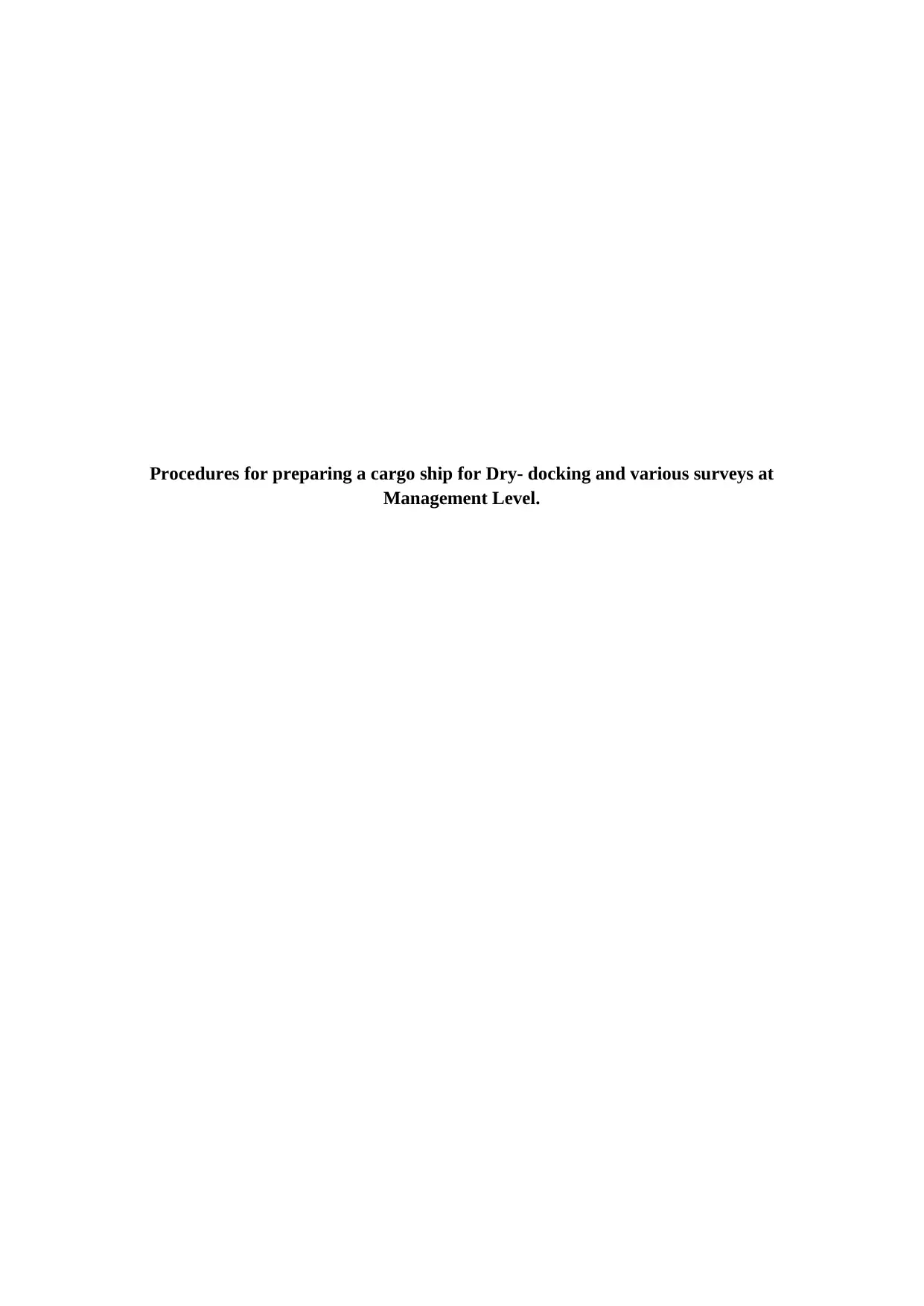
Procedures for preparing a cargo ship for Dry- docking and various surveys at
Management Level.
Management Level.
Paraphrase This Document
Need a fresh take? Get an instant paraphrase of this document with our AI Paraphraser
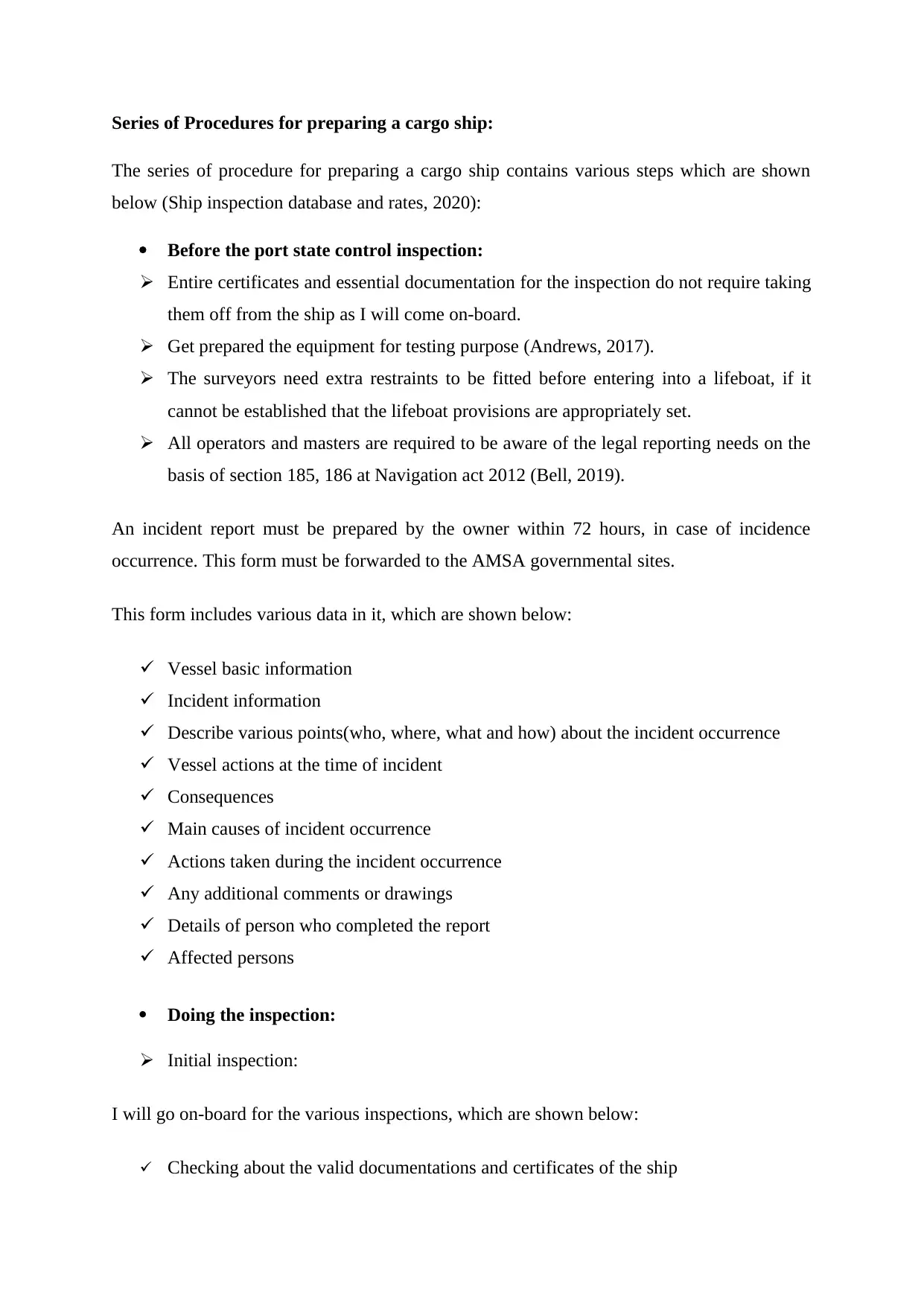
Series of Procedures for preparing a cargo ship:
The series of procedure for preparing a cargo ship contains various steps which are shown
below (Ship inspection database and rates, 2020):
Before the port state control inspection:
Entire certificates and essential documentation for the inspection do not require taking
them off from the ship as I will come on-board.
Get prepared the equipment for testing purpose (Andrews, 2017).
The surveyors need extra restraints to be fitted before entering into a lifeboat, if it
cannot be established that the lifeboat provisions are appropriately set.
All operators and masters are required to be aware of the legal reporting needs on the
basis of section 185, 186 at Navigation act 2012 (Bell, 2019).
An incident report must be prepared by the owner within 72 hours, in case of incidence
occurrence. This form must be forwarded to the AMSA governmental sites.
This form includes various data in it, which are shown below:
Vessel basic information
Incident information
Describe various points(who, where, what and how) about the incident occurrence
Vessel actions at the time of incident
Consequences
Main causes of incident occurrence
Actions taken during the incident occurrence
Any additional comments or drawings
Details of person who completed the report
Affected persons
Doing the inspection:
Initial inspection:
I will go on-board for the various inspections, which are shown below:
Checking about the valid documentations and certificates of the ship
The series of procedure for preparing a cargo ship contains various steps which are shown
below (Ship inspection database and rates, 2020):
Before the port state control inspection:
Entire certificates and essential documentation for the inspection do not require taking
them off from the ship as I will come on-board.
Get prepared the equipment for testing purpose (Andrews, 2017).
The surveyors need extra restraints to be fitted before entering into a lifeboat, if it
cannot be established that the lifeboat provisions are appropriately set.
All operators and masters are required to be aware of the legal reporting needs on the
basis of section 185, 186 at Navigation act 2012 (Bell, 2019).
An incident report must be prepared by the owner within 72 hours, in case of incidence
occurrence. This form must be forwarded to the AMSA governmental sites.
This form includes various data in it, which are shown below:
Vessel basic information
Incident information
Describe various points(who, where, what and how) about the incident occurrence
Vessel actions at the time of incident
Consequences
Main causes of incident occurrence
Actions taken during the incident occurrence
Any additional comments or drawings
Details of person who completed the report
Affected persons
Doing the inspection:
Initial inspection:
I will go on-board for the various inspections, which are shown below:
Checking about the valid documentations and certificates of the ship
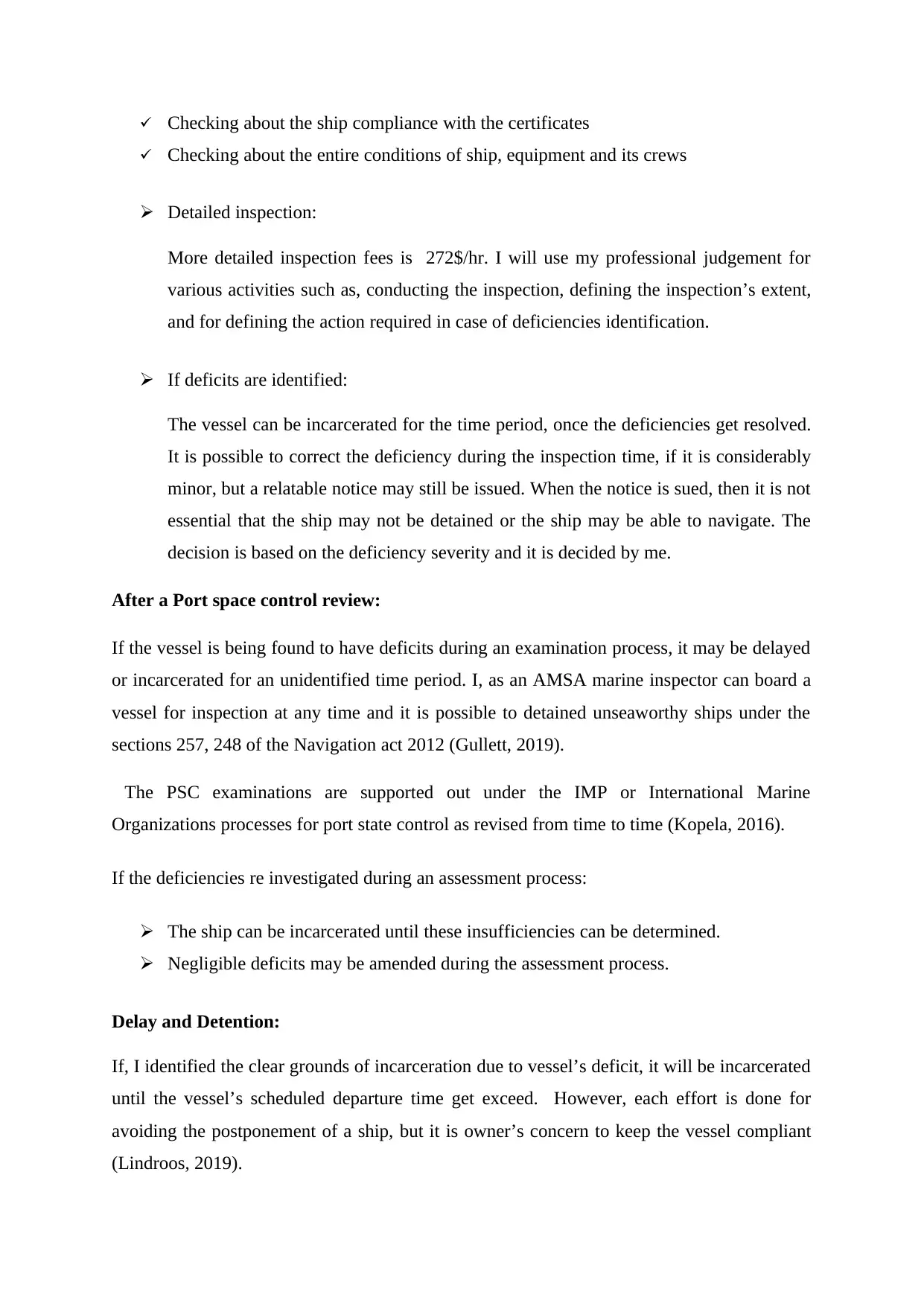
Checking about the ship compliance with the certificates
Checking about the entire conditions of ship, equipment and its crews
Detailed inspection:
More detailed inspection fees is 272$/hr. I will use my professional judgement for
various activities such as, conducting the inspection, defining the inspection’s extent,
and for defining the action required in case of deficiencies identification.
If deficits are identified:
The vessel can be incarcerated for the time period, once the deficiencies get resolved.
It is possible to correct the deficiency during the inspection time, if it is considerably
minor, but a relatable notice may still be issued. When the notice is sued, then it is not
essential that the ship may not be detained or the ship may be able to navigate. The
decision is based on the deficiency severity and it is decided by me.
After a Port space control review:
If the vessel is being found to have deficits during an examination process, it may be delayed
or incarcerated for an unidentified time period. I, as an AMSA marine inspector can board a
vessel for inspection at any time and it is possible to detained unseaworthy ships under the
sections 257, 248 of the Navigation act 2012 (Gullett, 2019).
The PSC examinations are supported out under the IMP or International Marine
Organizations processes for port state control as revised from time to time (Kopela, 2016).
If the deficiencies re investigated during an assessment process:
The ship can be incarcerated until these insufficiencies can be determined.
Negligible deficits may be amended during the assessment process.
Delay and Detention:
If, I identified the clear grounds of incarceration due to vessel’s deficit, it will be incarcerated
until the vessel’s scheduled departure time get exceed. However, each effort is done for
avoiding the postponement of a ship, but it is owner’s concern to keep the vessel compliant
(Lindroos, 2019).
Checking about the entire conditions of ship, equipment and its crews
Detailed inspection:
More detailed inspection fees is 272$/hr. I will use my professional judgement for
various activities such as, conducting the inspection, defining the inspection’s extent,
and for defining the action required in case of deficiencies identification.
If deficits are identified:
The vessel can be incarcerated for the time period, once the deficiencies get resolved.
It is possible to correct the deficiency during the inspection time, if it is considerably
minor, but a relatable notice may still be issued. When the notice is sued, then it is not
essential that the ship may not be detained or the ship may be able to navigate. The
decision is based on the deficiency severity and it is decided by me.
After a Port space control review:
If the vessel is being found to have deficits during an examination process, it may be delayed
or incarcerated for an unidentified time period. I, as an AMSA marine inspector can board a
vessel for inspection at any time and it is possible to detained unseaworthy ships under the
sections 257, 248 of the Navigation act 2012 (Gullett, 2019).
The PSC examinations are supported out under the IMP or International Marine
Organizations processes for port state control as revised from time to time (Kopela, 2016).
If the deficiencies re investigated during an assessment process:
The ship can be incarcerated until these insufficiencies can be determined.
Negligible deficits may be amended during the assessment process.
Delay and Detention:
If, I identified the clear grounds of incarceration due to vessel’s deficit, it will be incarcerated
until the vessel’s scheduled departure time get exceed. However, each effort is done for
avoiding the postponement of a ship, but it is owner’s concern to keep the vessel compliant
(Lindroos, 2019).
⊘ This is a preview!⊘
Do you want full access?
Subscribe today to unlock all pages.

Trusted by 1+ million students worldwide
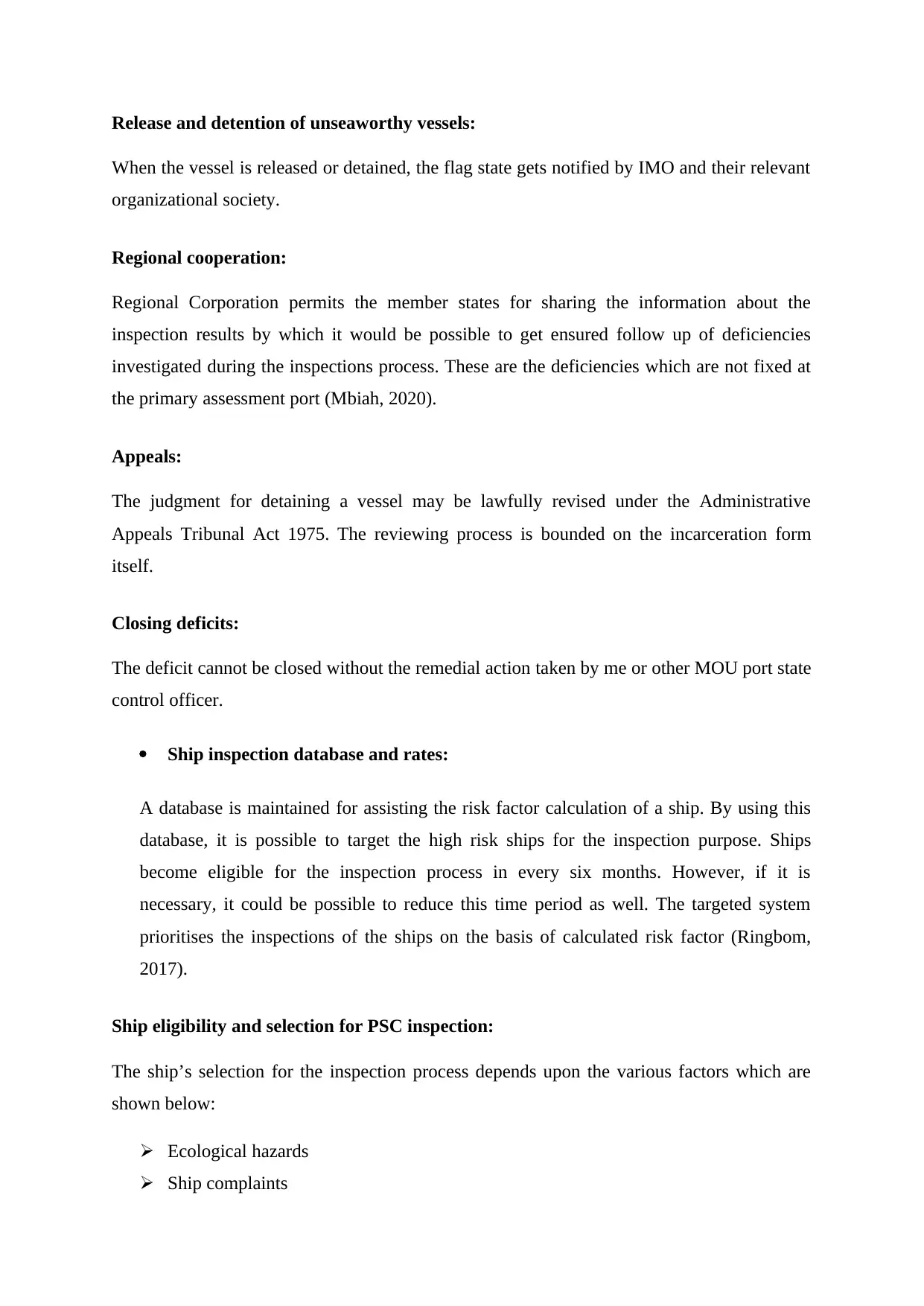
Release and detention of unseaworthy vessels:
When the vessel is released or detained, the flag state gets notified by IMO and their relevant
organizational society.
Regional cooperation:
Regional Corporation permits the member states for sharing the information about the
inspection results by which it would be possible to get ensured follow up of deficiencies
investigated during the inspections process. These are the deficiencies which are not fixed at
the primary assessment port (Mbiah, 2020).
Appeals:
The judgment for detaining a vessel may be lawfully revised under the Administrative
Appeals Tribunal Act 1975. The reviewing process is bounded on the incarceration form
itself.
Closing deficits:
The deficit cannot be closed without the remedial action taken by me or other MOU port state
control officer.
Ship inspection database and rates:
A database is maintained for assisting the risk factor calculation of a ship. By using this
database, it is possible to target the high risk ships for the inspection purpose. Ships
become eligible for the inspection process in every six months. However, if it is
necessary, it could be possible to reduce this time period as well. The targeted system
prioritises the inspections of the ships on the basis of calculated risk factor (Ringbom,
2017).
Ship eligibility and selection for PSC inspection:
The ship’s selection for the inspection process depends upon the various factors which are
shown below:
Ecological hazards
Ship complaints
When the vessel is released or detained, the flag state gets notified by IMO and their relevant
organizational society.
Regional cooperation:
Regional Corporation permits the member states for sharing the information about the
inspection results by which it would be possible to get ensured follow up of deficiencies
investigated during the inspections process. These are the deficiencies which are not fixed at
the primary assessment port (Mbiah, 2020).
Appeals:
The judgment for detaining a vessel may be lawfully revised under the Administrative
Appeals Tribunal Act 1975. The reviewing process is bounded on the incarceration form
itself.
Closing deficits:
The deficit cannot be closed without the remedial action taken by me or other MOU port state
control officer.
Ship inspection database and rates:
A database is maintained for assisting the risk factor calculation of a ship. By using this
database, it is possible to target the high risk ships for the inspection purpose. Ships
become eligible for the inspection process in every six months. However, if it is
necessary, it could be possible to reduce this time period as well. The targeted system
prioritises the inspections of the ships on the basis of calculated risk factor (Ringbom,
2017).
Ship eligibility and selection for PSC inspection:
The ship’s selection for the inspection process depends upon the various factors which are
shown below:
Ecological hazards
Ship complaints
Paraphrase This Document
Need a fresh take? Get an instant paraphrase of this document with our AI Paraphraser
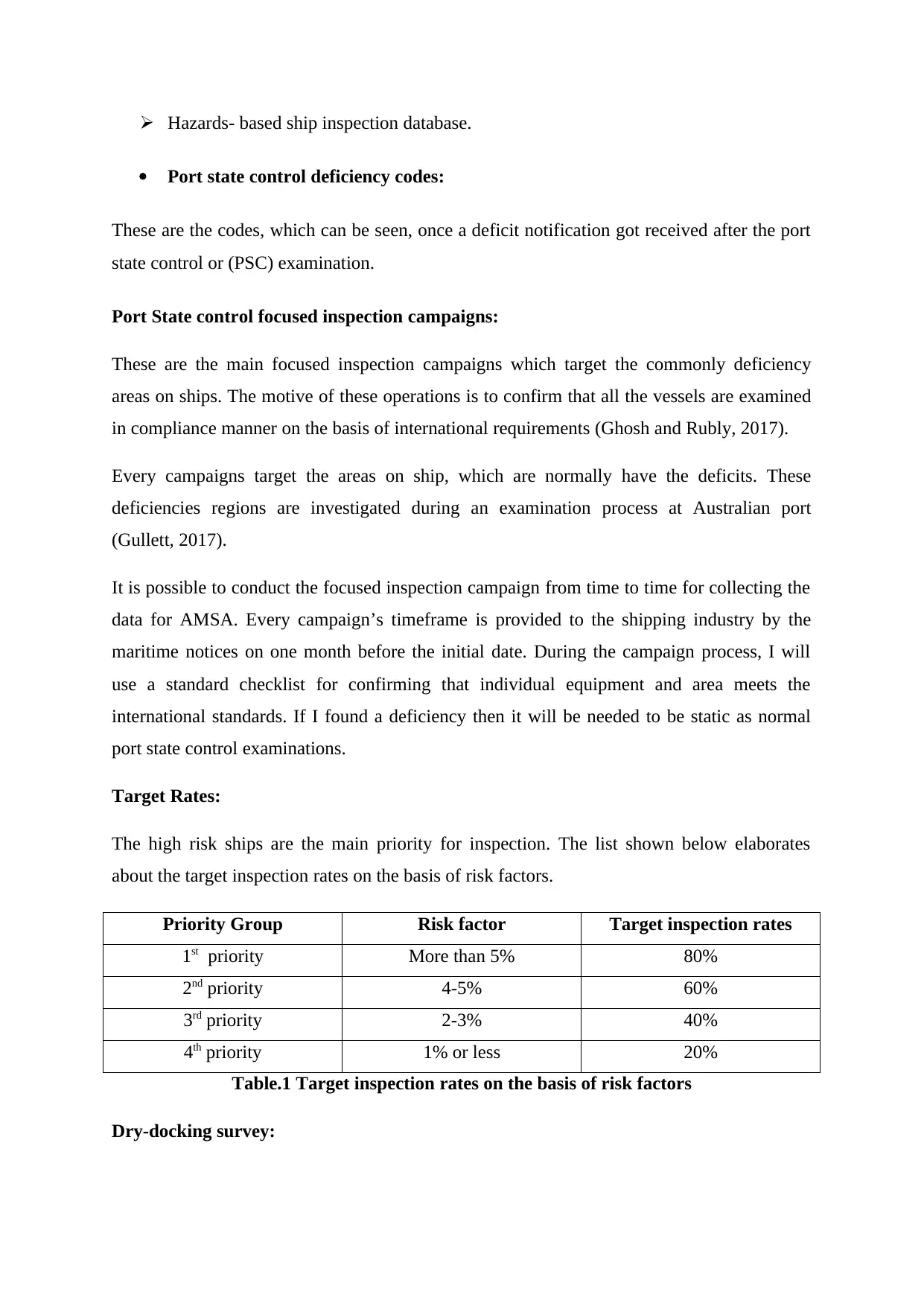
Hazards- based ship inspection database.
Port state control deficiency codes:
These are the codes, which can be seen, once a deficit notification got received after the port
state control or (PSC) examination.
Port State control focused inspection campaigns:
These are the main focused inspection campaigns which target the commonly deficiency
areas on ships. The motive of these operations is to confirm that all the vessels are examined
in compliance manner on the basis of international requirements (Ghosh and Rubly, 2017).
Every campaigns target the areas on ship, which are normally have the deficits. These
deficiencies regions are investigated during an examination process at Australian port
(Gullett, 2017).
It is possible to conduct the focused inspection campaign from time to time for collecting the
data for AMSA. Every campaign’s timeframe is provided to the shipping industry by the
maritime notices on one month before the initial date. During the campaign process, I will
use a standard checklist for confirming that individual equipment and area meets the
international standards. If I found a deficiency then it will be needed to be static as normal
port state control examinations.
Target Rates:
The high risk ships are the main priority for inspection. The list shown below elaborates
about the target inspection rates on the basis of risk factors.
Priority Group Risk factor Target inspection rates
1st priority More than 5% 80%
2nd priority 4-5% 60%
3rd priority 2-3% 40%
4th priority 1% or less 20%
Table.1 Target inspection rates on the basis of risk factors
Dry-docking survey:
Port state control deficiency codes:
These are the codes, which can be seen, once a deficit notification got received after the port
state control or (PSC) examination.
Port State control focused inspection campaigns:
These are the main focused inspection campaigns which target the commonly deficiency
areas on ships. The motive of these operations is to confirm that all the vessels are examined
in compliance manner on the basis of international requirements (Ghosh and Rubly, 2017).
Every campaigns target the areas on ship, which are normally have the deficits. These
deficiencies regions are investigated during an examination process at Australian port
(Gullett, 2017).
It is possible to conduct the focused inspection campaign from time to time for collecting the
data for AMSA. Every campaign’s timeframe is provided to the shipping industry by the
maritime notices on one month before the initial date. During the campaign process, I will
use a standard checklist for confirming that individual equipment and area meets the
international standards. If I found a deficiency then it will be needed to be static as normal
port state control examinations.
Target Rates:
The high risk ships are the main priority for inspection. The list shown below elaborates
about the target inspection rates on the basis of risk factors.
Priority Group Risk factor Target inspection rates
1st priority More than 5% 80%
2nd priority 4-5% 60%
3rd priority 2-3% 40%
4th priority 1% or less 20%
Table.1 Target inspection rates on the basis of risk factors
Dry-docking survey:
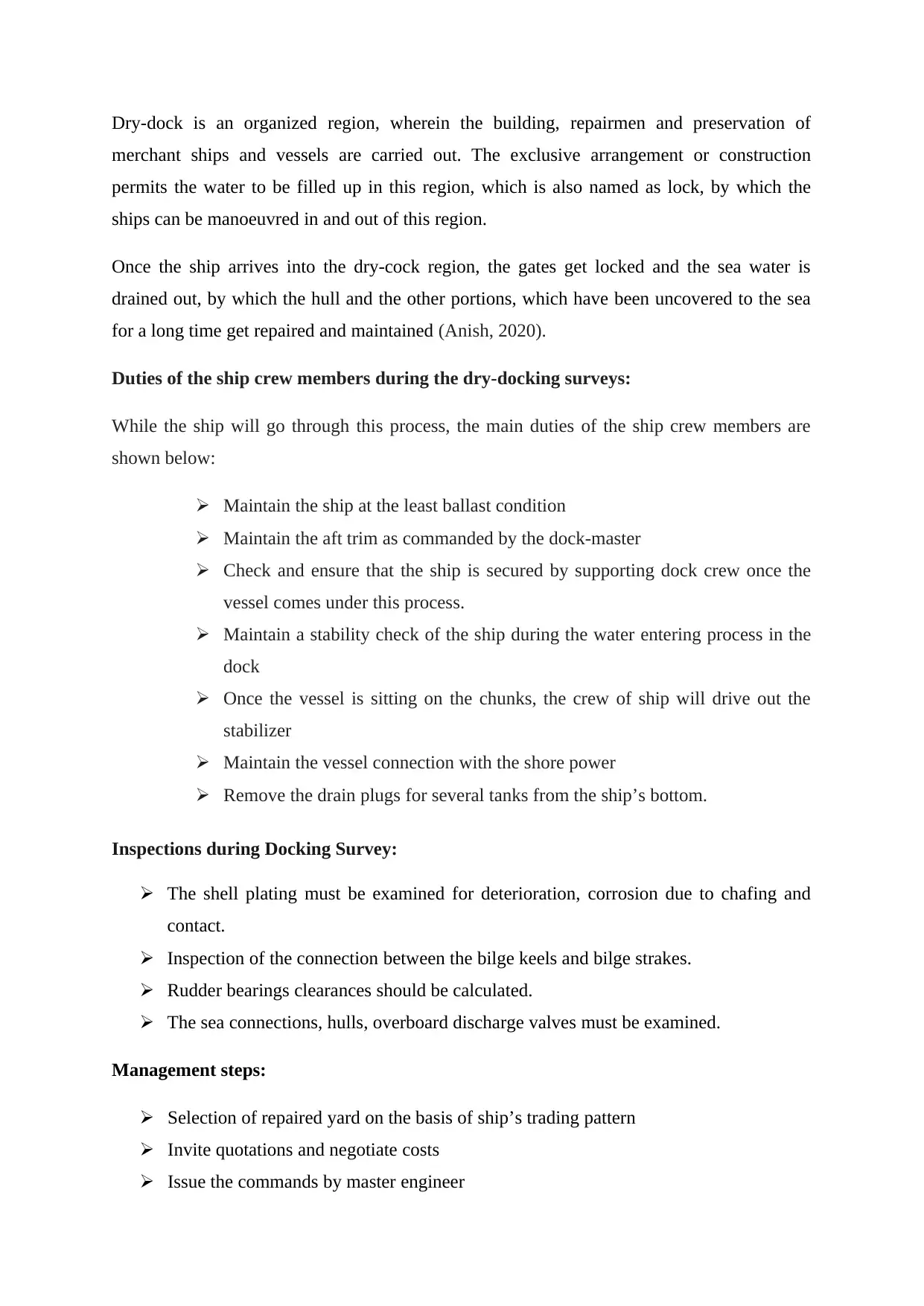
Dry-dock is an organized region, wherein the building, repairmen and preservation of
merchant ships and vessels are carried out. The exclusive arrangement or construction
permits the water to be filled up in this region, which is also named as lock, by which the
ships can be manoeuvred in and out of this region.
Once the ship arrives into the dry-cock region, the gates get locked and the sea water is
drained out, by which the hull and the other portions, which have been uncovered to the sea
for a long time get repaired and maintained (Anish, 2020).
Duties of the ship crew members during the dry-docking surveys:
While the ship will go through this process, the main duties of the ship crew members are
shown below:
Maintain the ship at the least ballast condition
Maintain the aft trim as commanded by the dock-master
Check and ensure that the ship is secured by supporting dock crew once the
vessel comes under this process.
Maintain a stability check of the ship during the water entering process in the
dock
Once the vessel is sitting on the chunks, the crew of ship will drive out the
stabilizer
Maintain the vessel connection with the shore power
Remove the drain plugs for several tanks from the ship’s bottom.
Inspections during Docking Survey:
The shell plating must be examined for deterioration, corrosion due to chafing and
contact.
Inspection of the connection between the bilge keels and bilge strakes.
Rudder bearings clearances should be calculated.
The sea connections, hulls, overboard discharge valves must be examined.
Management steps:
Selection of repaired yard on the basis of ship’s trading pattern
Invite quotations and negotiate costs
Issue the commands by master engineer
merchant ships and vessels are carried out. The exclusive arrangement or construction
permits the water to be filled up in this region, which is also named as lock, by which the
ships can be manoeuvred in and out of this region.
Once the ship arrives into the dry-cock region, the gates get locked and the sea water is
drained out, by which the hull and the other portions, which have been uncovered to the sea
for a long time get repaired and maintained (Anish, 2020).
Duties of the ship crew members during the dry-docking surveys:
While the ship will go through this process, the main duties of the ship crew members are
shown below:
Maintain the ship at the least ballast condition
Maintain the aft trim as commanded by the dock-master
Check and ensure that the ship is secured by supporting dock crew once the
vessel comes under this process.
Maintain a stability check of the ship during the water entering process in the
dock
Once the vessel is sitting on the chunks, the crew of ship will drive out the
stabilizer
Maintain the vessel connection with the shore power
Remove the drain plugs for several tanks from the ship’s bottom.
Inspections during Docking Survey:
The shell plating must be examined for deterioration, corrosion due to chafing and
contact.
Inspection of the connection between the bilge keels and bilge strakes.
Rudder bearings clearances should be calculated.
The sea connections, hulls, overboard discharge valves must be examined.
Management steps:
Selection of repaired yard on the basis of ship’s trading pattern
Invite quotations and negotiate costs
Issue the commands by master engineer
⊘ This is a preview!⊘
Do you want full access?
Subscribe today to unlock all pages.

Trusted by 1+ million students worldwide

References
Paraphrase This Document
Need a fresh take? Get an instant paraphrase of this document with our AI Paraphraser
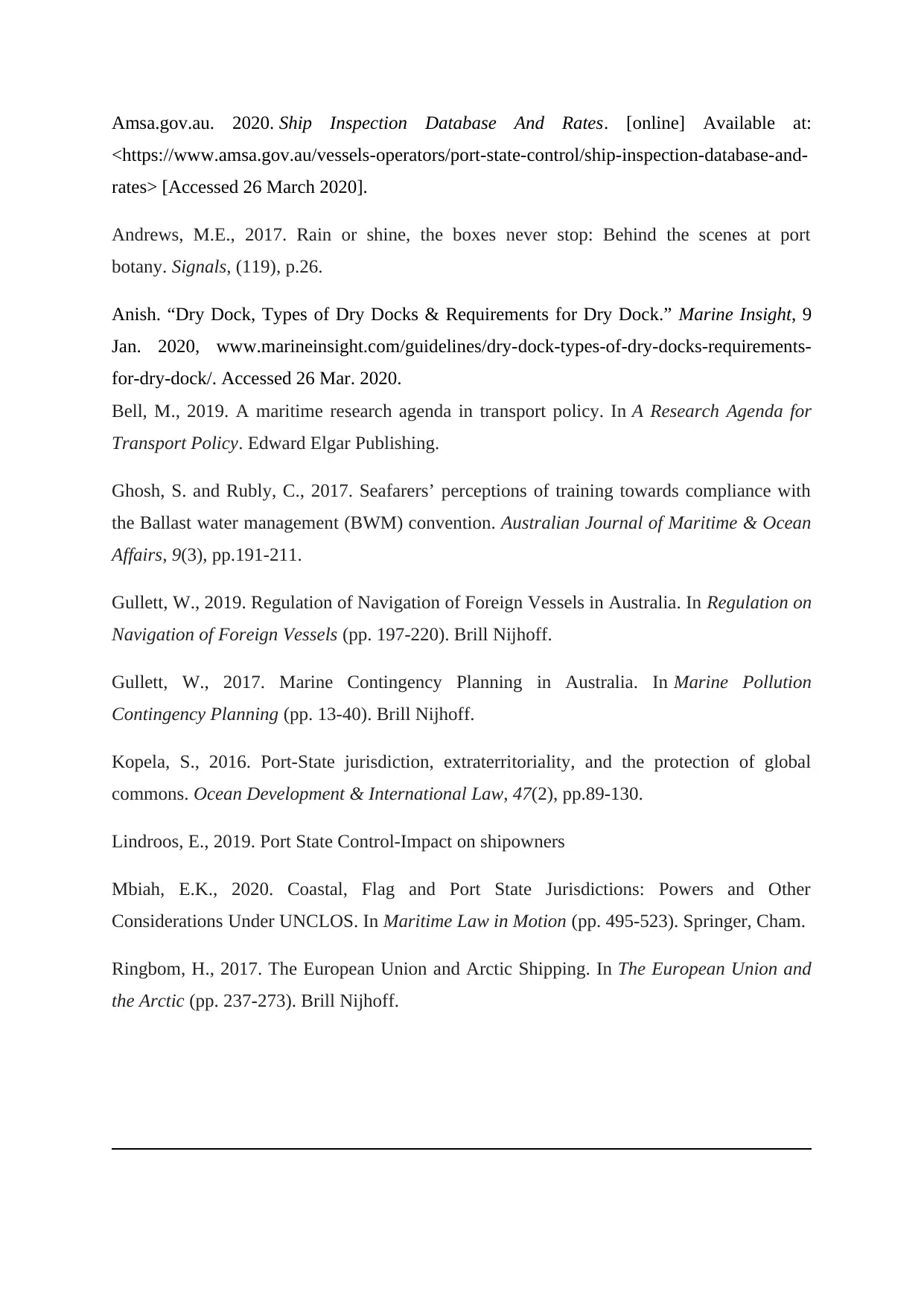
Amsa.gov.au. 2020. Ship Inspection Database And Rates. [online] Available at:
<https://www.amsa.gov.au/vessels-operators/port-state-control/ship-inspection-database-and-
rates> [Accessed 26 March 2020].
Andrews, M.E., 2017. Rain or shine, the boxes never stop: Behind the scenes at port
botany. Signals, (119), p.26.
Anish. “Dry Dock, Types of Dry Docks & Requirements for Dry Dock.” Marine Insight, 9
Jan. 2020, www.marineinsight.com/guidelines/dry-dock-types-of-dry-docks-requirements-
for-dry-dock/. Accessed 26 Mar. 2020.
Bell, M., 2019. A maritime research agenda in transport policy. In A Research Agenda for
Transport Policy. Edward Elgar Publishing.
Ghosh, S. and Rubly, C., 2017. Seafarers’ perceptions of training towards compliance with
the Ballast water management (BWM) convention. Australian Journal of Maritime & Ocean
Affairs, 9(3), pp.191-211.
Gullett, W., 2019. Regulation of Navigation of Foreign Vessels in Australia. In Regulation on
Navigation of Foreign Vessels (pp. 197-220). Brill Nijhoff.
Gullett, W., 2017. Marine Contingency Planning in Australia. In Marine Pollution
Contingency Planning (pp. 13-40). Brill Nijhoff.
Kopela, S., 2016. Port-State jurisdiction, extraterritoriality, and the protection of global
commons. Ocean Development & International Law, 47(2), pp.89-130.
Lindroos, E., 2019. Port State Control-Impact on shipowners
Mbiah, E.K., 2020. Coastal, Flag and Port State Jurisdictions: Powers and Other
Considerations Under UNCLOS. In Maritime Law in Motion (pp. 495-523). Springer, Cham.
Ringbom, H., 2017. The European Union and Arctic Shipping. In The European Union and
the Arctic (pp. 237-273). Brill Nijhoff.
<https://www.amsa.gov.au/vessels-operators/port-state-control/ship-inspection-database-and-
rates> [Accessed 26 March 2020].
Andrews, M.E., 2017. Rain or shine, the boxes never stop: Behind the scenes at port
botany. Signals, (119), p.26.
Anish. “Dry Dock, Types of Dry Docks & Requirements for Dry Dock.” Marine Insight, 9
Jan. 2020, www.marineinsight.com/guidelines/dry-dock-types-of-dry-docks-requirements-
for-dry-dock/. Accessed 26 Mar. 2020.
Bell, M., 2019. A maritime research agenda in transport policy. In A Research Agenda for
Transport Policy. Edward Elgar Publishing.
Ghosh, S. and Rubly, C., 2017. Seafarers’ perceptions of training towards compliance with
the Ballast water management (BWM) convention. Australian Journal of Maritime & Ocean
Affairs, 9(3), pp.191-211.
Gullett, W., 2019. Regulation of Navigation of Foreign Vessels in Australia. In Regulation on
Navigation of Foreign Vessels (pp. 197-220). Brill Nijhoff.
Gullett, W., 2017. Marine Contingency Planning in Australia. In Marine Pollution
Contingency Planning (pp. 13-40). Brill Nijhoff.
Kopela, S., 2016. Port-State jurisdiction, extraterritoriality, and the protection of global
commons. Ocean Development & International Law, 47(2), pp.89-130.
Lindroos, E., 2019. Port State Control-Impact on shipowners
Mbiah, E.K., 2020. Coastal, Flag and Port State Jurisdictions: Powers and Other
Considerations Under UNCLOS. In Maritime Law in Motion (pp. 495-523). Springer, Cham.
Ringbom, H., 2017. The European Union and Arctic Shipping. In The European Union and
the Arctic (pp. 237-273). Brill Nijhoff.

⊘ This is a preview!⊘
Do you want full access?
Subscribe today to unlock all pages.

Trusted by 1+ million students worldwide
1 out of 9
Your All-in-One AI-Powered Toolkit for Academic Success.
+13062052269
info@desklib.com
Available 24*7 on WhatsApp / Email
![[object Object]](/_next/static/media/star-bottom.7253800d.svg)
Unlock your academic potential
Copyright © 2020–2025 A2Z Services. All Rights Reserved. Developed and managed by ZUCOL.